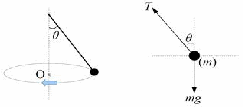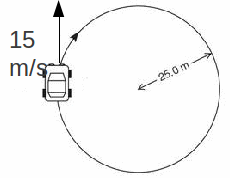The phrase 'uniform circular motion' describes planar motion in a circle at constant speed. If the motion takes place on the Earth, this almost certainly means that the motion is horizontal.
For example a mass suspended at the end of a string may be made to describe uniform circular motion as illustrated below left.

Though the speed of the the object is constant, the direction is constantly changing. If the direction were not constantly changing, the object would move in a line. This means that the object is subject to a force towards the centre of the circle, O above. The force is supplied by the component of tension,![]() towards the centre of the circle as shown in the diagram above right. The mass experiences an acceleration according to Newton's second law of motion. The acceleration, called the centripetal acceleration, is towards the centre of the circle, O above. It's magnitude is given by
towards the centre of the circle as shown in the diagram above right. The mass experiences an acceleration according to Newton's second law of motion. The acceleration, called the centripetal acceleration, is towards the centre of the circle, O above. It's magnitude is given by![]() then Newton's second law,
then Newton's second law,![]() tells us that
tells us that![]()
Example: A car of mass 1200 kg moves on a circle of radius 25 m at 15 m/s .

The force to keep the car moving in a circle is exerted by the force of friction between the tyres and the ground.
![]() and
and![]()
It is important to note that the force acting towards the centre of the circle does no work since the mass does not move in the direction of the force. If this were not the case, the planets could not move in a circle around the Sun.
